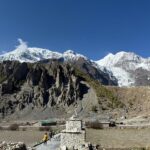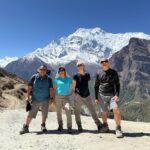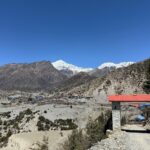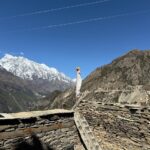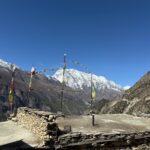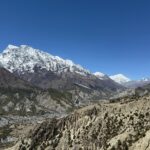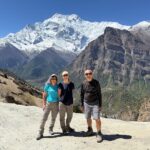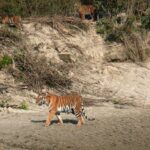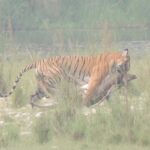
Best Time for Trek in Nepal
Best Time for Trek in Nepal – Nepal is a small country, but it has a wide range of landscapes. There are mountain peaks, rolling hills, humid jungles, and high-altitude deserts. People and cultures from all over the world live on this varied land, so the Nepali calendar is full of festivals, celebrations, and special events.
Whether you’re here to trek through the Himalayas, go on a jungle safari to look for rhinos, or visit the temples of the Kathmandu Valley, which are hundreds of years old, it pays to know when to go. Most tourists visit Nepal in the spring or fall, when the weather is warm and the sky is clear. This is when trekking and other outdoor activities are best.
Fewer people come here in the winter, when the trails are icy and the hills are covered in snow, and in the summer monsoon, when it’s hard to get around because of the rain and the views are hidden by thick clouds.
Here is our guide to the best time to go to Nepal for trekking, visiting temples, and other activities.
“Mountains are the beginning and the end of all natural scenery.”
By John Ruskin
Table of Contents
- Main Season
- Winter Season In Nepal
- Where to go in the winter season
- Spring Season In Nepal
- Where to go in the spring season
- Summer Season In Nepal
- Where to go in the summer season
- Autumn Season In Nepal
- Where to go in the autumn season
- Nepal In January
- Nepal In February
- Nepal In March
- Nepal In April
- Nepal In May
- Nepal In June
- Nepal In July
- Nepal In August
- Nepal In September
- Nepal In October
- Nepal In November
- Nepal In December
Main Season
Higher up, it gets cold in the winter, but it’s a great time to visit Nepal because the skies are so clear. Trekking in the lower Himalayan foothills and the jungles of Chitwan and Bardia in the south of Nepal are both great in the winter.
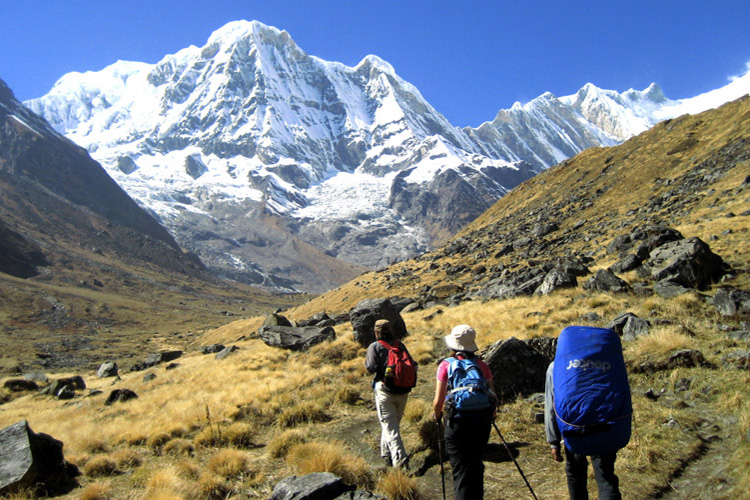
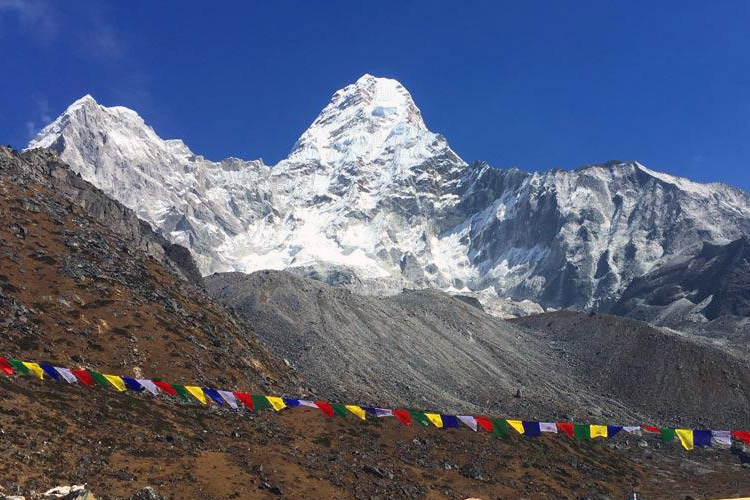
Trekking in Nepal is most popular in the spring, when temperatures rise steadily and the weather is usually more stable. But there are more people on the trails, and the sky can be hazy at times. In the spring, there are many fun celebrations, like Holi in March and the Nepalese New Year in April.
Summer is the monsoon season. It is hot and humid, and most places where people go trekking have cloudy skies and rain. Choose a trek in the “rain shadow” of the Himalaya, such as Upper Mustang or Nar Phu, at this time of year. In June, the Yarthung Horse Festival is held in Manang.
Most people go hiking in the fall because the weather is usually stable, the temperatures are mild, and the skies are usually clear. Since the weather is at its best, so are the number of people there. Dashain (in October) and Tihar are two of the biggest festivals in the fall (November).
Winter Season in Nepal
Winter in Nepal is cold and dry, and snow sometimes falls in the mountains. Since the sky is usually very clear, winter is one of the best times to see the 8,000m Himalayan giants in a clear, crisp way. There are fewer people, so you’ll have most of the views to yourself. Check out our list of the best Nepal winter treks.
Where to go in winter season
Most of the time, it’s too cold in the winter to trek in Nepal’s high mountain areas or cross high passes on the classic treks. In the winter, the foothills of Nepal below 4,000 meters/13,000 feet are great. At night, it gets cold, but during the day, it’s usually not too bad, especially if you hike and warm up. Some local experts say that winter is the best time to hike the treks in the lower Solu area south of Everest and the shorter treks near Pokhara. The lowlands, which include Chitwan and Bardia National Parks, have mild winters and are beautiful places to visit.
Spring season in Nepal
Spring is one of the best times to go trekking in Nepal, along with autumn. This is because the weather is stable, which makes it perfect for crossing high passes on the classic treks in Nepal. One bad thing about spring is that the sky can get hazy, making it hard to see the mountains. On the popular trekking routes, you’ll meet people from all over the world, which is good for some but bad for those who like to be alone in nature.
Where to go in spring season
In Nepal, the weather is stable in the spring in the higher mountains where the classic treks are. This is a great time to cross high passes like Larkya La (on the Manaslu Circuit Trek), Kongma La (on the Three Passes Trek), and Thorung La (on the Annapurna Circuit Trek) and trek to high viewpoints in Nepal like Kala Pattar and Gokyo Ri in the Everest Region. Choose a trek that isn’t on the main path if you want to avoid crowds. Kathmandu gets warmer, and Thamel, which is a tourist area, becomes a place where a lot of people want to go. Bardia National Park is the best place to see tigers, and it gets very hot there.
Summer season in Nepal
Summer is the monsoon season which means the weather is hot and humid, and it tends to rain on most days. Wildflowers are in full bloom, and the foothills are lush. Monsoon usually starts in early June and continues into early September. In summer it’s advisable to have some flexibility in your travel plans as flight delays and cancellations are more common due to cloudy weather. Landslides may occur, causing road and trail closures, and views are often obstructed. Also, leeches can be an annoyance.
Where to go in summer season
Treks located in the rain shadow of the Himalayas are best during monsoon, such as Upper Mustang, Nar Phu, Upper Dolpo and Limi Valley. Higher areas in the Everest region are also good. Kathmandu is hot and humid, and the lowlands in the south are even hotter, but if you can withstand the heat they offer great wildflowers, lush jungle and the possibility of tiger sightings.
Autumn season in Nepal
Most people go trekking in Nepal in the fall. Nepal is also a great place to visit because of its culture. There are lots of festivals, and the colors of nature are bright because everything has just been washed and the plants have grown strong during the monsoon. People from all over the world come to enjoy these great conditions, so the trails are usually busy and the teahouses are usually full.
Where to go in autumn season
Nepal’s classic treks are best in the fall, just like they are in the spring. The same treks are recommended as in the section about the spring. The skies are usually clearer in autumn, which gives it a slight edge over spring. This advantage is somewhat cancelled out by the large number of people, so it’s best to look into less popular treks. As for other places to go and things to do, all of Nepal is accessible in the fall, and the weather is usually mild, making it a great time to travel.
Nepal in January
During the winter, the evenings in Kathmandu Valley can be cool, and trekking areas at higher altitudes can be very cold. Some hiking paths may be blocked by snow, and many teahouse and lodge owners will close their doors. On the other hand, the Terai is warm and ready to be explored.
Nepal in February
At the start of spring, both the number of tourists and the temperature rise. In late February, it’s a good time to go to the Terai national parks, go trekking at lower altitudes, and hang out in Pokhara, a traveler town with a mild climate. There are a number of important events, like the Hindu festival Holi, which can also happen in March. It is a celebration of the end of winter and the triumph of good over evil. People throw huge amounts of brightly colored powder at each other. When Losar, the Tibetan New Year, comes around in February or March, many Buddhist monasteries hold parties.
Nepal in March
As the weather keeps getting warmer, there are more people in the hiking areas, and trails at higher altitudes can be used again. However, cloud cover makes it hard to see the mountains at this time of year. The Terai is a great place to go on safari right now.
Nepal in April
After October and November, April is the second most popular time to go trekking. The Terai and other low-lying places are getting hotter and stickier, but there are lots of chances to see wildlife. This is a great month to visit Bhaktapur because it celebrates the New Year with Bisket Jatra. During Bisket Jatra, huge wooden chariots pull temple effigies through the winding streets of the city center
Nepal in May
In the days before the monsoon, temperatures rise in the Kathmandu Valley, the Terai, and trekking areas at lower elevations, and afternoon rain showers become more common. But this is the best time for mountaineering trips to Everest and other nearby peaks because the weather is good at higher altitudes.
Chitwan and Bardia are also good places to see tigers in May. When you look at the calendar of events, you can see that on Buddha Jayanti, there are big Buddhist celebrations in Lumbini, Boudhanath, Swayambhunath, and other places. However, the city of Patan has its biggest festival, with processions and chariot parades for the god Rato Machhendranath.
Nepal in June
The monsoon usually starts in the middle of June, but the date can change by several weeks from one year to the next. Expect swollen rivers, mudslides, leeches, and trails that are too muddy to walk on. During this time, the number of tourists drops, but so do prices. Expect problems on the roads and in the air.
Nepal in July
Nepal is still getting hit by the monsoon, but there are a few high trans-Himalayan valleys that don’t get as bad of the weather and are still good for trekking. Upper Mustang is one of them. It has a semi-arid climate and a lot of Tibetan culture.
Nepal in August
In August, it rains a lot every day. The land is green and there is a lot of it in the farming areas. This month is full of Hindu holidays, like Krishna Jayanta, which is the birthday of the Hindu god Krishna, and Teej, which is a three-day festival for women (which starts at the end of July in 2022). Naga Panchami is a fun time to visit Bhaktapur because it honors the snake spirits of Nepal’s rivers, ponds, and temple tanks.
Nepal in September
Most of the time, the monsoon ends around the middle of September, bringing clearer skies. People are starting to come back because the weather is warm, the landscape is green, and the rivers have a lot of water in them, which makes for great whitewater rafting. This is also the time of the Indra Jatra festival, which is one of the biggest in Kathmandu. The Kumari, who is known as Kathmandu’s “living goddess,” makes a rare public appearance during this festival.
Nepal in October
Nepal’s high season starts, with great views of the Himalayas, warm weather, and perfect conditions for trekking. Demand goes through the roof for rooms, flights, and trekking lodges, so book everything well in advance. Dasain, Nepal’s biggest festival, is also happening at this time. It is a 15-day celebration of the Hindu goddess Durga’s victory over the buffalo demon Mahisa-sura (it can also fall in September). The Hindu Festival of Lights, called Tihar or Diwali, takes place in October or November, depending on when the moon is full.
Nepal in November
Peak season lasts until November, when there are still a lot of tourists and the weather is great for hiking, mountain biking, rafting, paragliding, and other outdoor activities. Many people come to the Solu Khumbu area around Everest to see the interesting Sherpa festival of Mani Rimdu (in some years it takes place in October).
Nepal in December
As winter gets colder, the number of travelers slowly starts to drop. Temperatures drop, snow piles block high mountain passes, and it becomes much harder to hike to places like Everest Base Camp and Annapurna Base Camp. This month, when the weather is still warm, is a good time to visit the national parks and religious sites in the Terai. The Pokhara Street Festival, a big party with cultural performances, parades, and street food, brought a lot of people to the city. If you want to stay in Pokhara, you should book your room well in advance.

